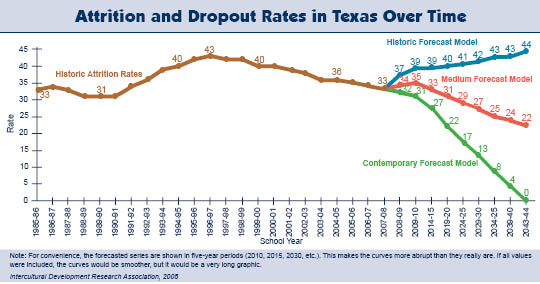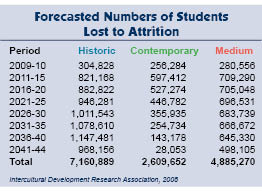Will the Texas High School Attrition Rate Ever Drop to Zero?
Felix Montes, Ph.D.
In an effort to estimate when the attrition rate will diminish to negligible values, we used three lineal regression models (see graph).
Historic Forecast Model
The first model takes into account all known historic values, from year 1986 to 2008, as determined by the annual IDRA longitudinal attrition studies (Johnson, 2008). This model assumes that the each past rate has equal weight over future rates. For this Historic Forecast Model, all future attrition values within the model horizon will be higher than the current value, since the model constructs the current downward trend as a cyclical bottom within the long-term upward progression of the curve. In this formulation, the next attrition rate should be around 37 percent, as the current rate (33 percent) would be the lowest point within the curve current cycle, given its full historical trend. Following this trend, the attrition rate will continue to increase slowly and reach 44 percent around the year 2044. This value will just exceed the previous highest point, 43 percent, reached in 1997.
Contemporary Forecast Model
The second model assumes that the current downward trend is a more reasonable predictor of future attrition values. The fact that these are chronologically the most recent values supports this assumption. The recent past is usually more relevant than the distant past. Consequently, this Contemporary Forecast Model uses the values corresponding to the years 1997 to 2008, which represents the subsection of the historic series portraying the current downward trend. In this model, the attrition rate will drop slightly to 32 percent next year (2008-09) and will continue to decrease until it reaches zero around the year 2044.
Medium Forecast Model
The third model takes a centrist view between the Historic and Contemporary Forecast models. Mathematically, it is formed by applying the means between the pairs of corresponding two model values within the models time horizon. Because of the strong influence of past history, this Medium Forecast Model predicts that attrition rates first will increase slightly to 34 percent in 2009 and 35 percent in 2010; then it will resume its downward trend during the subsequent years. However, it will still be 22 percent around the year 2044.
Forecasted Student Losses
To understand the severity of the situation, we used the three forecast models to estimate the number of students that will be lost to attrition during the time horizon under consideration (see table).
The Historic Forecast Model predicts that more than 7.16 million students will be lost to attrition from 2009 to 2044. The Contemporary Model yields a figure of more than 2.6 million students, and the Medium Forecast Model more than 4.88 million students.
Conclusions
- If we take the full historic values as a guide, the student dropout rate should be expected to continue to increase for the foreseeable future. Under this scenario more than 7.16 million additional students will be lost to attrition by the year 2044.
- If we assume that current downward trend is real – the result of systemic changes – the attrition rate will reach single digit values in the mid 2030s. By 2040, the attrition rate will be about 4 percent, and it will reach zero in the year 2044. However, from now to that point, we would have lost more than 2.6 million students to attrition.
- A more realistic model suggests that current rates will increase slightly before resuming a downward trend. In this scenario, by the year 2044, attrition will still be at about 22 percent, and during the period 2009 to 2044, we will have lost more than 4.88 million students.
Therefore, we should expect high attrition rates, in the 30s, for the next few years. We should also expect to lose between 2.6 million and 7.16 million additional students to attrition before we reach a zero attrition rate, unless this issue is considered seriously by policymakers and systemic changes implemented to ameliorate the problem.
Reference
Johnson, R.L. "Texas Public School Attrition Study, 2007-08 – At Current Pace, Schools Will Lose Many More Generations," IDRA Newsletter (San Antonio, Texas: Intercultural Development Research Association, October 2008).
© Intercultural Development Research Association, October 2008
IDRA is an independent, private non-profit organization, directed by María Robledo Montecel, Ph.D., dedicated to creating schools that work for all children. As a vanguard leadership development and research team for more than three decades, IDRA has worked with people to create self-renewing schools that value and empower all children, families and communities. IDRA conducts research and development activities, creates, implements and administers innovative education programs and provides teacher, administrator, and parent training and technical assistance.



